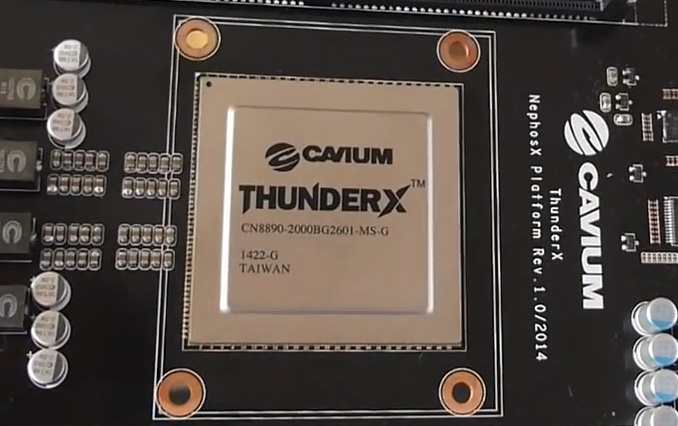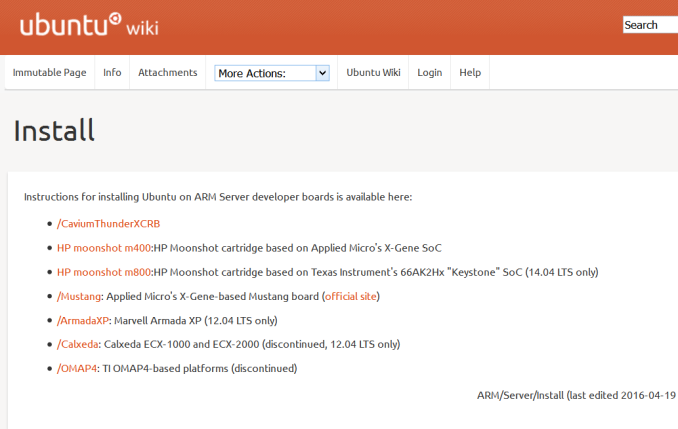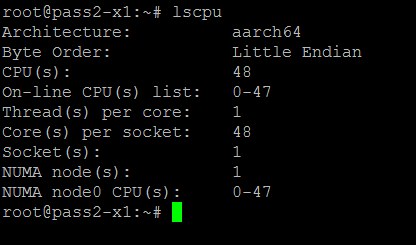Investigating Cavium's ThunderX: The First ARM Server SoC With Ambition
by Johan De Gelas on June 15, 2016 8:00 AM EST- Posted in
- SoCs
- IT Computing
- Enterprise
- Enterprise CPUs
- Microserver
- Cavium

When is a worthy alternative to Intel's Xeon finally going to appear? That is the burning question in the server world. If PowerPoint presentations from various ARM-based SoCs designers released earlier this decade were to be believed, Intel would now be fighting desperately to keep a foothold in the low end server market. But the ARM SoCs so far have always disappointed: the Opteron A1100 was too late, the X-Gene 1 performed poorly, consumed too much power, and Broadcomm's Vulcan project is most likely dead. This Ubuntu page is an excellent illustration of the current state of the ARM server market:
Discontinued products, many announced products which do not even appear on this page (we are in the middle of 2016, after all), and despite the fact that there is an ARM Server Base System Architecture (SBSA) specification, every vendor has its own installation procedure. It is still a somewhat chaotic scene.
Meanwhile, Intel listened to their "hyperscaler customers" (Facebook, Google...) and delivered the Xeon D. We reviewed Intel's Broadwell SoC and we had to conclude that this was one of the best products that Intel made in years. It is set a new performance per watt standard and integrated a lot of I/O. The market agreed: Facebook's new web farms were built upon this new platform, ARM servers SoCs were only successful in the (low end) storage server world. To make matter worse, Intel expanded the Xeon D line with even higher performing 12 and 16 core models.
But losing a battle does not mean you lose the war. Finally, we have a working and available ARM server SoC which has more ambition than beating the old Atom C2000 SoC. In fact, Cavium's ThunderX SoC has been shipping since last year, but you need more than silicon to get a fully working server. Firmware and kernel need to get along, and most libraries need to be compiled with platform-specific optimizations. So the quality assurance teams had a lot of work to do before Cavium could ship a server that could actually run some server software in a production environment. But that work has finally been finished. Cavium send us the Gigabyte R120-T30 running Ubuntu 14.04 server with a ThunderX ready Linux kernel (4.2.0) and ThunderX optimized tools (gcc 5.2.0 etc.).
Cavium?
Who is Cavium anyway? Even for those working in the enterprise IT, it is not a well known semiconductor company. Still, Cavium has proven itself as fabless network/security/storage and video SoC designing company. The company based in San José counts IBM, Juniper, Qualcomm, Netgear, Cisco among its customers.
With a net revenue of about $400 million, Cavium is about one-tenth the size of AMD. But then again, Cavium either reports small losses or smal profits despite heavy investments in the new ARMv8 project ThunderX. In other words, the company's financials look healthy. And Cavium did already design a 16-core MIPS64 Octeon Network Service Processor (NSP) back in 2006. So Cavium does have a lot of experience with high core count SoCs: the network processor Octeon III CN78xx has 48 of them.
Handling server applications is of course very different from network processing. A large amount of independent network packets creates a lot of parallelism, and more complex computation can be offloaded to co-processors. Still, Cavium is the first vendor that delivers an ARMv8 server chip with an impressive core count: no less than 48 cores can be found inside the ThunderX die.
To keep the design effort reasonable, Cavium based their first ARMv8 server processor, ThunderX, on the Octeon III CN78xx. We described this in more detail here, but the main trade-off is that Cavium used a relatively simple dual issue core. As a result, single threaded performance is expected to be relatively low. On the opposite side of the coin however, it is the first ARM SoC that has claimed throughput numbers in the realm of the best Xeon D and even midrange Xeon E5, instead of competing with the Atom C2000. It is the most ambitious ARMv8 SoC that has made it into production.
All of this gives us plenty of reasons to put the Cavium ThunderX through paces. And throwing in the latest Supermicro boards with the latest 12 and 16 core Xeon-Ds made it a lot more interesting ...












82 Comments
View All Comments
silverblue - Thursday, June 16, 2016 - link
I'm not sure how this is relevant. Johan doesn't review graphics cards, other people at Anandtech do. I bet Guru3D has a much bigger team for that, and I imagine that they have a much narrower scope (i.e. no server stuff).I don't think I've looked at a review recently that hasn't had the comments section polluted with "where is the review for x".
UrQuan3 - Wednesday, June 15, 2016 - link
Intel allows their Xeons to sometimes pull double their TDP? No wonder our new machines trip breakers long before I thought they would. I need to test instead of assuming accurate documentation.I can see why you chose C-Ray, I'm just sorry a more general ray tracer was not chosen. Still, not it's intended market, though I am suddenly very interested. Ray-tracing and video encoding are my top two tasks.
Meteor2 - Thursday, June 16, 2016 - link
The 'T' in 'TDP' is for thermal. It's a measure of the maximum waste heat which needs to be removed over a certain period of time.UrQuan3 - Wednesday, June 22, 2016 - link
Yes, it stands for thermal, but power doesn't consumed doesn't just disappear. Convert it to light, convert it to motion, convert it to heat, etc. In this case there is a small amount of motion (electrons) and the rest has to be heat. I expect much higher instantaneous pulls, but this was sustained power. Anyway, I will track down the AVX documentation mentioned below.I saw the h264ref. I'll be curious about x264 (handbrake) as the authors seem interested in ARM in the last few years. Unsurprisingly, it is far less optimized than x64. I benchmarked handbrake on the Pi2, Pandaboard, and CI-20 last year, just to see what it would do.
JohanAnandtech - Thursday, June 16, 2016 - link
C-Ray was just a place holder to measure FPU energy consumption. I look into bringing a more potent raytracer into our benchmark suite (povray)Video encoding was in the review though, somewhat (h264ref).
patrickjp93 - Friday, June 17, 2016 - link
ARM chips with vector extensions allow it as well. Intel provides separate documentation for AVX-workload TDPs.Antony Newman - Wednesday, June 15, 2016 - link
Fascinating article.Why would Cavium not try and use 54 x A73s in their next chip?
If ARM are not in the business of making Silicon, and ARM think the '1.2W Ares' will help them break into the Server market ... Then Why do we think ARM isn't working with the likes of Cavium to get a Server SoC that rocks the Intel boat?
Typos From memory : send -> sent. Through-> thought. There were a few others.
AJ
name99 - Thursday, June 16, 2016 - link
How do you know ARM aren't working with such a vendor?ARM has always said that they expect ARM server CPUs to only be marginally competitive (for very limited situations) in 2017, and to only be really competitive in 2020.
That suggests, among other things, that if they are working with partners, they have a target launch between those two dates, and they regard all launches before 2017 as essentially nice for PR and fr building up the ecosystem, but essentially irrelevant for commercial purposes.
rahvin - Thursday, June 16, 2016 - link
The problem as pointed out early in this article is that ARM keeps targeting Intel's current products, not the ones that will be out when they get their products out. We've had almost a dozen vendors get to the point of releasing the chip and drop it because it is simply not competitive with Intel. Most of these arm products were under taken when Intel was targeting performance without regard to performance/watt. Now that intel targets the later metric arm server chips haven't been competitive with them.Fact is Intel could decimate and totally take over all the markets arm chips occupy, but to do it they'd have to cannibalize their existing high profit sales. This is why they keep canceling Atom chips, the chips turned out so good they were worried they'd cannibalize much more expensive products. This is the reason Avoton is highly restricted in what products and price segments it's allowed into. If Intel opened the flood gates on Avoton they would risk cannibalizing their own server profits.
junky77 - Wednesday, June 15, 2016 - link
So, they did what AMD couldn't for years? I'm trying to figure it out.. their offering seems to be a lot more interesting than AMD's stuff currently